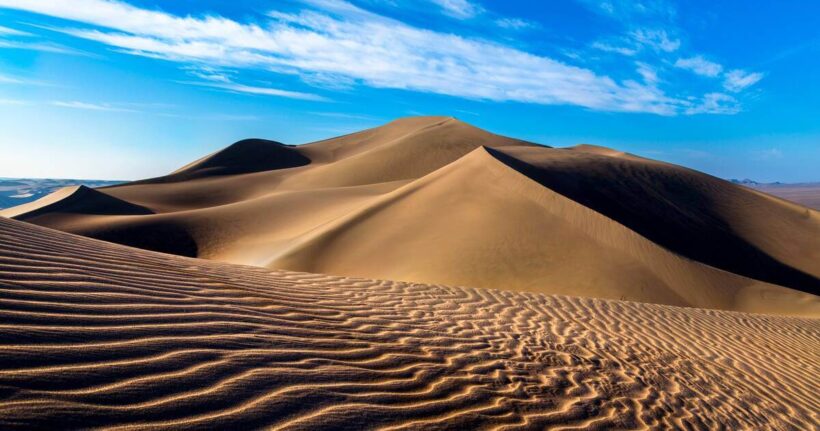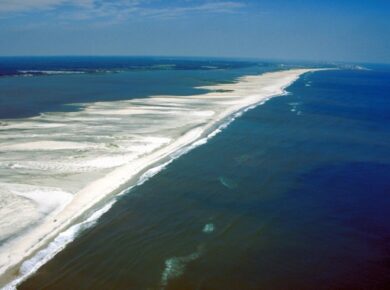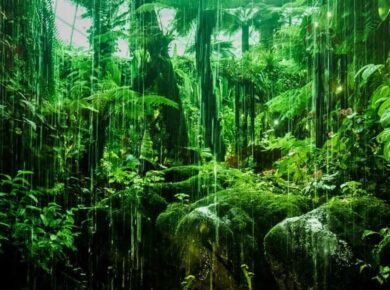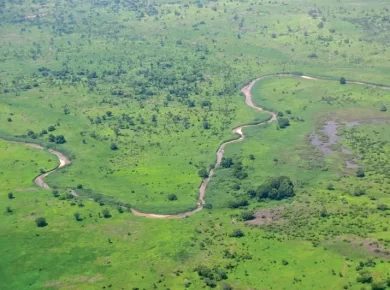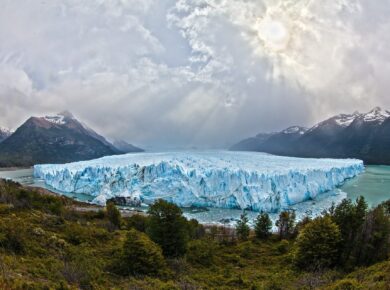Desert Landforms & Erosion Mechanism
Deserts
- About 1/5th of the world’s land is made up of deserts.
- Deserts which are absolutely barren, where nothing grows are known as true deserts.
- Insufficient & irregular rainfall, high temperature & rapid rate of evaporation are the main causes of desert’s aridity.
- Almost all the deserts are confined within 15* – 30* parallels to N – S of equator known as trade wind desert or tropical deserts.
- They lie in the trade wind belt on the western parts of the continents.
- Offshore trade winds are often bathed in cold currents which produces a desiccating (dehydrating) effect; hence moisture is not easily condensed into precipitation.
Deserts Landforms
| Canyon | Alluvial Fan | Mesa |
| Butte | Inselberg | Salt Pan |
| Oasis | Blowouts | Sand Dunes |
| Yardang | Zeugen | Mushroom rocks |
Types of Deserts
Hamada / Rocky Desert
- Consist of large stretches of bare rocks, swept clear of sand & dust by wind.
- Exposed rocks are thoroughly smoothened, polished & highly sterile.
Reg / Stony Desert
- Composed of extensive sheets of angular pebbles & gravels which the wind is not able to blow off.
- Stony deserts are more accessible than sandy deserts & large herds of camels kept there.
Erg / Sandy Desert
- Also known as sea of sand
- Winds deposit vast stretches of undulating sand dunes in the direction of winds.
Badlands
- Consists of gully & ravines formed on hill slopes & rock surfaces by the extent of water action
- Not fit for agriculture & survival
- Finally leads to the abandonment of entire region by its inhabitants.
Mountain Deserts
- Deserts which are found on the highlands such as on plateaus & mountain ranges, where erosion has dissected the desert highland into rough chaotic peaks & uneven ranges.
- Their steep slopes consist of Wadis (dry valleys) with sharp & irregular edges carved due to action of frost.
Mechanism of Desert / Arid Erosion
Weathering
- Most potent factor in reducing rocks to sand in arid regions.
- Even though the amount of rain that falls in a desert is small but manage to penetrate into rocks & sets up chemical reactions in various minerals it contains.
- Intense heating during the day & rapid cooling during the night by radiations, set up stresses in already weakened rocks, hence they eventually crack.
- When water gets into cracks of a rock, it freezes at night as the temperature drops below the freezing point & expands by 10 % of its volume.
- Successive freezing will prise of fragments of rocks which get accumulated as screes.
- As heat penetrates rock, its outer surface gets heated & expands, leaving its inner surface comparatively cool.
- Hence, outer surface prise itself from the inner surface & peels off in successive thin layers, known as exfoliation.
Action of Wind
- Efficient in arid regions as little vegetation or moisture to bind the loose surface materials
- Carried out in following ways –
Deflation
- Involves lifting & blowing away of loose materials from the ground
- Blowing capacity depending largely on the size of the material lifted from the surface
- Finer dust & sands may be removed miles away from their place of origin & may get deposited even outside the desert margins.
- Deflation results in the lowering of the land surface to form large depressions called Deflation hollows
Abrasion
- Sand blasting of rock surfaces by wind when they hurl sand particles against them
- This results in rock surfaces being scratched, polished & worn away
- Abrasion is most effective near the base of the rocks, where the amount of material the wind is able to carry is greatest.
- This explains why telegraphic poles in the deserts are protected by covering of metal for a foot or two above the ground.
Attrition
- When wind borne particles roll against one another in collision, they wear each other away
- Hence their sizes are greatly reduced & grains are rounded into millet seed sand
For more updates about Desert Landforms & Erosion Mechanism, explore the Geography . Feel free to share your thoughts and comments.
If you’re passionate about building a successful blogging website, check out this helpful guide at Coding Tag – How to Start a Successful Blog. It offers practical steps and expert tips to kickstart your blogging journey!
